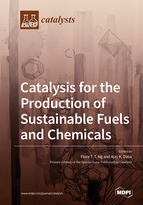Catalysis for the Production of Sustainable Fuels and Chemicals
A special issue of Catalysts (ISSN 2073-4344). This special issue belongs to the section "Biomass Catalysis".
Deadline for manuscript submissions: closed (30 November 2019) | Viewed by 72373
Special Issue Editors
Interests: solid acid catalysis; clean fuels; chemicals from biomass; process intensification; esterification; transesterification; hydrogenolysis; desulfurization; hydrocracking
Interests: hydro-deoxygenation; hydrogenolysis; hydrogenation; biomass; esterification and transesterification; pyrolysis; gasification; hydrothermal treatment; Fischer-Tropsch synthesis; hydroprocessing
Special Issues, Collections and Topics in MDPI journals
Special Issue Information
Dear Colleagues,
Green-house gas emissions and environmental concerns have led to recent research in the use of renewable feedstocks derived from biomass, waste oils, and fats as a source of fuels and chemicals. However, these feedstocks contain a large amount of oxygen functional groups. Processing these feedstocks generally requires esterification and transesterification, deoxygenation, hydrogenation, hydrogenolysis, aldol condensation and cracking reactions. In addition, the bio-oils produced through pyrolysis and hydrothermal treatment are treated through catalytic processes for producing clean fuels. In addition, syngas produced through gasification of biomass is converted to liquid fuels. The main focus of this Special Issue is to solicit recent advances in the catalytic processing of these renewable feedstocks to produce sustainable fuels and chemicals.
Prof. Flora T. T. Ng
Prof. Ajay K. Dalai
Guest Editors
Manuscript Submission Information
Manuscripts should be submitted online at www.mdpi.com by registering and logging in to this website. Once you are registered, click here to go to the submission form. Manuscripts can be submitted until the deadline. All submissions that pass pre-check are peer-reviewed. Accepted papers will be published continuously in the journal (as soon as accepted) and will be listed together on the special issue website. Research articles, review articles as well as short communications are invited. For planned papers, a title and short abstract (about 100 words) can be sent to the Editorial Office for announcement on this website.
Submitted manuscripts should not have been published previously, nor be under consideration for publication elsewhere (except conference proceedings papers). All manuscripts are thoroughly refereed through a single-blind peer-review process. A guide for authors and other relevant information for submission of manuscripts is available on the Instructions for Authors page. Catalysts is an international peer-reviewed open access monthly journal published by MDPI.
Please visit the Instructions for Authors page before submitting a manuscript. The Article Processing Charge (APC) for publication in this open access journal is 2700 CHF (Swiss Francs). Submitted papers should be well formatted and use good English. Authors may use MDPI's English editing service prior to publication or during author revisions.
Keywords
- Sustainable Fuels and Chemicals
- Hydrogenolysis
- Deoxygenation
- Esterification and Transesterification
- Hydroprocessing
- Cracking
- Pyrolysis
- Gasification
- Hydrothermal Treatment Biomass
- Bio-oil and Fats
- Catalysis







